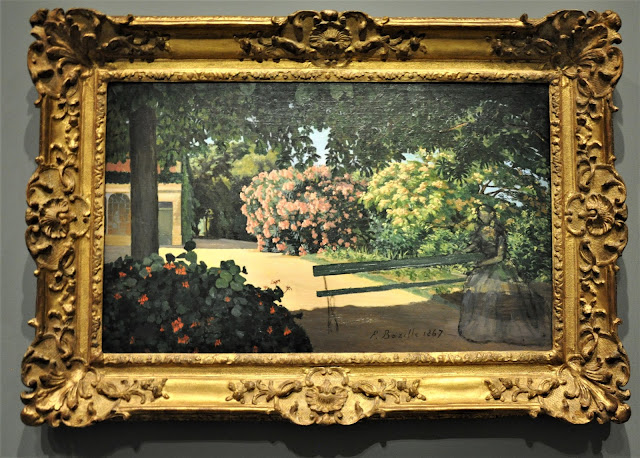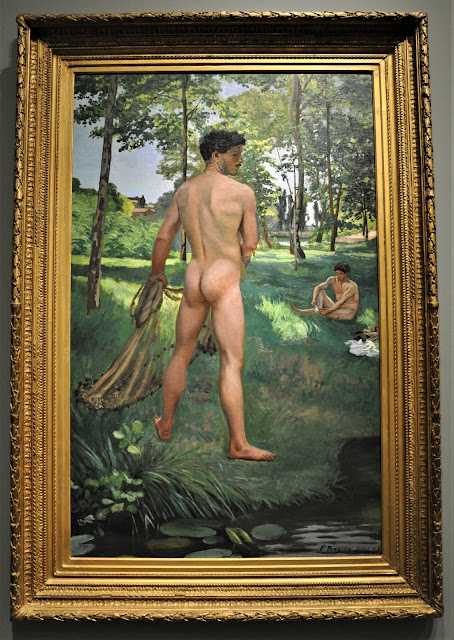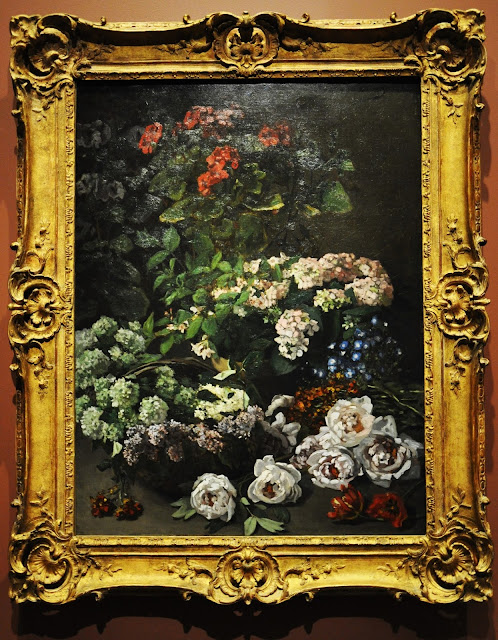If Frédéric Bazille had not been killed in 1870 at age 28 in the Franco-Prussian war, he would have equaled Claude Monet, Edgar Degas and Auguste Renoir in fame as an Impressionist painter. He was that good.
The painting below is the famous A Studio in Les Batignolles by Henri Fantin-Latour. Along with Édouard Manet (the painter), Claude Monet, Auguste Renoir, Émile Zola and others, the very tall man on the far right of the painting is Frédéric Bazille. This shows that Bazille was part of the main Impressionist group in the 1860s and 1870s. He only fell out of the group because he died so young.
Artists often painted their studios and Frédéric Bazille was no different. Note Bazille really liked his green upholstered chair because he included it in both of these paintings.
The Studio on the Rue la Condamine (1869-1870): In this painting Édouard Manet actually painted the figure of Bazille (Bazille is the tall gentleman in the middle; Manet is in front of him.) Monet and Renoir are on the stairs but who is who has never been determined. All of the paintings Bazille included in this work had all been rejected by the Paris Salon art exhibition jury.
The Artist's Studio on the Rue de Furstenberg (1865): Bazille shared this studio with Monet. Note that this painting is all about Monet: many of the paintings that Bazille included in this painting are actually of Monet himself or paintings by Monet. None of the works on display can actually be attributed to Bazille himself.
Improvised Field Hospital (1865): Bazille painted a bed-ridden Claude Monet recuperating after injurying his leg. This painting is one of the first works which shows Bazille's genius as an artist. Bazille incorporated a variety of patterns and textures in this painting from the floral wallpaper, geometric tiles, textured wood of the bed and the plaid of the mattress. Amazingly x-rays show all this was painted with no significant changes to the composition.
La Toilette (1870): Another work where Bazille shows his attention to detail. The young, nude courtesan is the least interesting thing in the painting compared to the brilliant colors and patterns detailed in the fur on the sofa, the black woman's skirt, the kimono robe and Turkish rug in the background. NOTE: In the painting above, The Studio on the Rue la Condamine, Bazille includes a study of this painting right above the sofa.
Oleanders (1867): In this painting Bazille experiments with the effects of sunlight and shadow in a landscape scene; here Bazille shows a succession of shadow, then bright sunshine, then back to shadow. The odd thing is Bazille later went back and started to add a green bench with a woman seated. He was never able to finish the painting before he was killed.
The Beach at Sainte-Adresse
(1865): Bazille learned so much from his friendship with Claude Monet
who was much more advanced in painting skills than Bazille at this time.
In May 1864, Bazille and Monet traveled to Normandy (where Monet grew
up). However, feeling a little intimated by Monet's superior skills at
outdoor (en plein air) painting, this was the only Normandy coast painting by Bazille. And he actually painted it in his studio over a year later, actually copying a similar painting by Monet.
Note the similarities to Monet's masterpiece, The Beach at Sainte-Adresse
(1864), below. (Photo courtesy Minneapolis Institute of Art). However, Monet's painting
appears to have been painted in a short period of time (literally
painted right there on the beach), Bazille, unfamiliar and not as
experienced painting directly outdoors, painted and reworked his version
inside his studio.
Fisherman With a Net
(1868): Here Bazille expresses his beauty of the male nude. Studies of
this painting also show no major alterations during its creation. It's a
wonderful painting showing the juxtaposition of the bright colors in
the background and the darker shades in the foreground.
Summer Scene: Bathers (1869-1870): This big painting (over 5 feet square) was Bazille's masterpiece. Much more experienced in en plein air painting at this point in his career, Bazille not only continues his interest in the *figure in the landscape*, but he also continued to experiment with the contrast between sunlight and shadow.
No one understood the reason why Frédéric Bazille felt compelled to volunteer in the Franco-Prussian War, a war France was doomed to lose from the beginning against a much more powerful Prussia. But Bazille felt himself in no danger: on November 27, 1870, while celebrating the promotion to sergeant-major, he stated, "I know for myself I won't get killed; I have too many things to do in life." Unfortunately the very next day he was killed in his first battle. Being over six feet tall probably didn't help (in the 1860s and 1870s, the average height for men was 5' 7" or 5' 8"). During his short life he only painted around 60 paintings. Despite missing success as an Impressionist painter, his work was not unknown at the time of his death, but it took some time for his work to be rediscovered (in a 1950 exhibition). Critics then and now all agree that Bazille certainly belongs with Monet, Renoir, Sisley, Degas and Morisot as one of the major founding artists of the Impressionist period.
The National Gallery of Art is located on the National Mall between 3rd and 9th Streets NW along Constitution Avenue. The entrance to the East Building is on 4th Street NW.
- Admission is ALWAYS free (even for exhibitions).
- Open Monday-Saturday: 10 a.m. - 5 p.m.
- Open Sunday: 11 a,m, - 6 p.m.
- Closed December 25 and January 1.
All photos (unless noted) were taken by me. Unauthorized use is strictly prohibited.














































